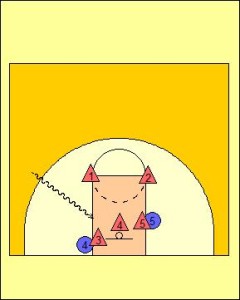Zone Offense: Interior Player Set-up
A Interior Players role when facing a Zone Defence can make or break a team in regards to providing opportunities, or being a passenger within the Zone Offense. Too many times because of interior players do not understand the tactics specific to their role when facing a zone defence they become ineffective and absent from a team’s zone offense points production. A team employing a specialised zone offense will want high percentage shots which often come from within the keyway and taken by the interior targets.
There are a few specialised points of note that need to be discussed with any player looking to fill an interior playing position against a zone defence. These however are sometimes overlooked in lieu of focusing on the movements or patterns within the zone offense rather than the specific breakdowns of each pass and opportunities presented.
Set-Up
The set-up for an offense against a zone defence is a simple, but still important aspect. When playing against a zone defence the space created by the position of the interior players is vital in not only finding shots within the offensive system, but also allowing players to create to make a scoring opportunity happen.

In the diagram above the position of offensive player (Four), means the defensive match-up Three (3) must move with the interior target and in doing so is pulled away from the usual alignment. This creates a bigger distance between the top and bottom players of this 2/3 Zone Defence. This additional space has a number of different benefits for the zone offense of the team.
The first is the defender (Three), in the most likely help position for the top guard on this side of the floor (One), is further away. This can mean a delay in helping or not even being able to reach a good defensive position at all. This poor defensive positioning increases the chances of a foul being committed by the defence and ultimately the offense gaining a scoring opportunity.
Defensive teams will often go into a zone defence to try and “hide” a player with a high foul count. Therefore, by having this player still exposed to fouling situations an opposition will gain no advantaged and still have to play with intensity and pressure.
The next benefit from this separation between defensive players is that it creates space into which the interior player(s) can move. Having the ability to post up, cut, seal, and screen is the lifeblood of a two-player zone offense. Creating space in this instance gives options, and therefore makes the offensive players more of a threat and harder to guard.
Finally, to help with the opportunities presented to perimeter players. From the diagram above, it can be seen that the gap between the top and bottom defenders is quite different on each side of the keyway due to the positioning of the interior players. This extra space is very valuable to perimeter players as they attempt to find driving lanes and high percentage scoring opportunities for themselves when facing a zone defence.
It should be noted that when a perimeter player drives there would most likely be a defensive rotation, which of course will present some opportunities for interior players to step into receiver spots and high scoring positions.
There are many very effective zone offenses available for team to implement. Nevertheless, it is often the little details that make a zone offense move from providing scoring opportunities, to bring consistency against a zone defence. As quickly as possible an offense wants to score in a run against a zone defence so they can build confidence and to wear down the defensive structure in general of the zone.







